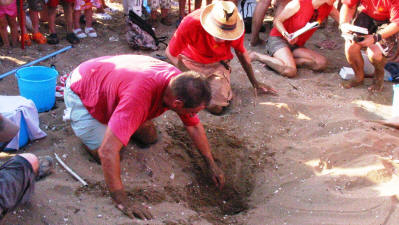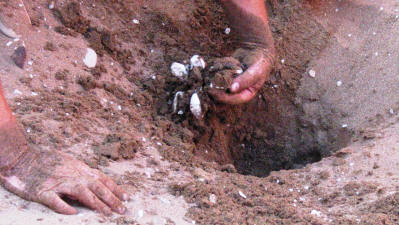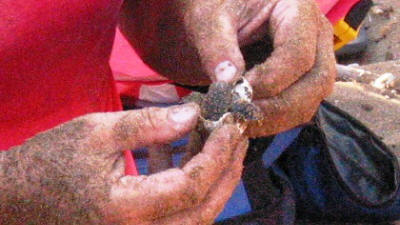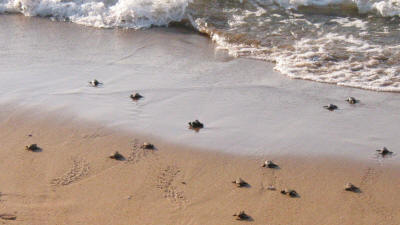Turtle Hatching in North Cyprus
 |
| A Nest Excavation at Alagadi |
During May to August, the Green and Loggerhead turtles lay their eggs on north Cyprus beaches. Around 50 days later, the turtles start to hatch. The peak season for hatching being August and September. Of the seven species of turtle worldwide, only the Green turtle (Chelonia mydas), and the Loggerhead Turtle (Caretta caretta) breed in the Mediterranean. Both are classified as endangered species. Both species are around the same size when they first hatch, even though the Green turtles grow much larger than the Loggerheads in later life. Their shells are around 4cm long and 3cm wide, and they weigh about 15g. The turtles only emerge from the nest after the sun has gone down to avoid predators, and so they don't dry out on their way to the sea.
 |
| Turtle Eggs Being Uncovered |
The turtles tend to hatch together, as the eggs are sensitive to movement, so the first turtle hatching triggers the others in a chain reaction. Once they have climbed to the surface, they all rush together for the brightest point, which is normally the moon reflecting off the sea. Unfortunately, if there are stronger lights away from the sea, that's the direction, they go in. Once heading in the right direction, however, they still have many hurdles to overcome on their way. Dogs and foxes enjoy a meal of baby turtle. They have rubbish and steep-sided vehicle tracks to overcome. They are attacked by gulls and crabs, and have to overcome careless humans walking on them. Once at sea they have to face sharks, speedboats, fishing lines and nets. It's little wonder that it is estimated only around 1 in 1000 reach adulthood.
 |
| A helping Hand |
Not all beaches are monitored, and it is important that if you spot some hatchlings heading for the sea you don't give them a hand, as it is essential that they find their own way.
Having reached the sea, they head a few kilometres offshore before starting to feed. At this stage, both turtles are omnivorous, although an adult Green Turtle is herbivorous. Since 1992 the Marine Turtle Research Group has been monitoring nesting turtles in North Cyprus. Although all beaches are checked where possible, the main centre is at Alagadi beach, just a few miles east of Kyrenia, in a building known throught the island as "The Goat Shed" where visitors can come and learn a little more about the turtles.
 |
| A Green Turtle Hatchling |
Coordinated by a group based at Exeter University, up to 30 students from all over the UK, pay their own way to come to North Cyprus to help conserve the turtles and monitor their behaviour. The teams of volunteers attempt to increase the survival rate of the turtle's nests, and therefore the hatchlings.
Monitoring hatching is more reliable than nesting, as the hatching date can be calculated based on the nesting date. When the students spot that some of the hatchlings have surfaced, they start to monitor the nest. Once the hatchlings have emerged, the nest is excavated. This means digging it up and getting any remaining hatchlings out. They are counted and recorded, and placed in a bucket with wet sand and covered with a wet cloth to keep them cool. They are then taken back to the goat shed to be weighed and measured, before being released to make their way to the sea.
 |
| The Rush for the Sea |
Public excavations take place most days, with the exception of Sundays, at approximately 6pm, with visitors wanting to observe, gathering at the goat shed. During these public excavations, visitors can watch hatchlings coming out of their nests, as well as see them entering the water. This is one of the most breathtaking and rare sights in nature. One which very few people have witnessed, and it is well worth a visit.
If you wish to witness a hatching, call in at the Goat Shed to see if an excavation is programmed for that day. Please do this in the afternoon, as the students will be catching up on their sleep after their night shift. Alagadi beach is 15Km east of Kyrenia on the Esentepe road. Shortly after the electricity station, where the road starts to sweep down into a valley, you will see the turning for Alagadi. Follow this road till you reach the fork in the road with the St Kathleen's Restaurant. Take the right fork and follow the road to where it becomes a dirt track. The goat shed is on your right, just after joining the track. It is a white single-story building with the painting of a turtle on the side.
To find out more about the Green and Loggerhead turtles in north Cyprus, about their nesting, or to read a volunteer's diary, follow the links.